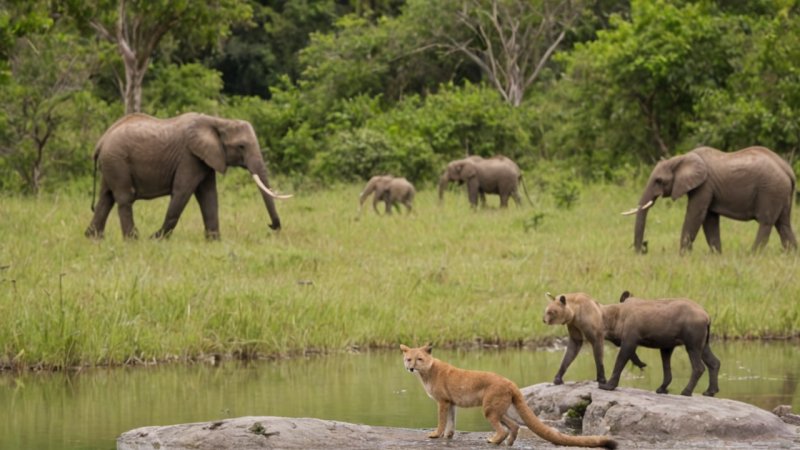Wildlife watching offers a unique opportunity to connect with nature and observe animals in their natural habitats. However, it's essential to approach these experiences responsibly to minimize our impact on the environment and the creatures we admire. Engaging in eco-friendly wildlife watching not only supports conservation efforts but also enhances your overall experience. Here are ten tips to ensure that your wildlife watching adventures are both enjoyable and sustainable.
1. Choose Responsible Tour Operators
Before embarking on your wildlife watching journey, research and select tour operators that prioritize sustainability and ethical practices. Look for companies that are certified by recognized conservation organizations and have a solid track record in wildlife protection. These operators often follow strict guidelines to ensure minimal disturbance to wildlife and their habitats. Additionally, they may contribute a portion of their profits to conservation projects, making your experience even more impactful.
2. Educate Yourself About the Species
Understanding the behavior and ecology of the species you hope to see is crucial for responsible wildlife watching. Before your trip, take some time to learn about the animals' habits, habitats, and conservation status. This knowledge will not only enhance your experience but also help you appreciate the challenges these species face in the wild. Moreover, being informed allows you to engage in discussions with guides and fellow travelers, fostering a community of eco-conscious enthusiasts.
3. Maintain a Safe Distance
When observing wildlife, it’s vital to respect their space. Approaching too closely can cause stress to animals and disrupt their natural behaviors. Always follow guidelines provided by your tour operator and local regulations regarding safe distances. A good rule of thumb is to observe animals from at least three times the distance of their body length. Use binoculars or a zoom lens to get a better view without intruding on their territory.
4. Avoid Feeding Wildlife
Feeding wild animals might seem harmless, but it can have detrimental effects on their health and behavior. Human food can be harmful to animals, and feeding them can lead to dependency on human sources for food. Additionally, it may encourage aggressive behavior towards humans or disrupt their natural foraging habits. Instead of feeding, consider bringing environmentally-friendly snacks for yourself and enjoying them at a safe distance from the wildlife.
5. Travel During Off-Peak Seasons
Choosing to travel during off-peak seasons can significantly reduce the pressure on wildlife populations and their habitats. High tourist traffic can lead to habitat degradation and increased stress for animals. By planning your wildlife watching trips during quieter times, you contribute to a more peaceful environment for both animals and fellow travelers. Plus, off-peak travel often rewards you with a more intimate and fulfilling experience.
6. Leave No Trace
Adopting the Leave No Trace principles is essential for eco-friendly wildlife watching. Always clean up after yourself, disposing of waste properly and minimizing your impact on the environment. Stay on designated paths to protect native vegetation and avoid trampling sensitive habitats. If you’re camping, use biodegradable soap and pack out all trash, including food scraps, to ensure that wildlife is not attracted to human waste.
7. Support Conservation Efforts
Many wildlife watching destinations have local conservation initiatives that benefit from visitor support. Consider participating in activities that promote conservation, such as volunteering for a local project or contributing to a trust fund that supports wildlife protection. Your involvement can help preserve the habitats you enjoy and ensure that future generations can also experience the beauty of the natural world.
8. Use Eco-Friendly Transportation
Getting to your wildlife watching destination can also impact the environment. Opt for eco-friendly transportation options whenever possible, such as public transport, carpooling, or using bicycles. If you're flying, consider offsetting your carbon footprint by investing in carbon offset programs. Every small effort counts in reducing your overall environmental impact and supporting a more sustainable travel model.
9. Respect Local Cultures and Communities
Wildlife habitats often overlap with local communities, and respecting the cultural practices and livelihoods of these communities is crucial. Engage with local guides and learn about their perspectives on wildlife conservation. Supporting local economies through ethical tourism practices can foster a sense of stewardship towards wildlife and promote sustainable practices in the community.
10. Share Your Experiences
After your wildlife watching adventure, share your experiences with friends, family, and social media followers. Use your platform to promote eco-friendly practices and raise awareness about the importance of wildlife conservation. By sharing your journey, you can inspire others to travel responsibly and appreciate the beauty of the natural world.
Engaging in eco-friendly wildlife watching is not just a trend; it’s a responsibility that every traveler should embrace. By following these tips, you can make a positive impact on the environment and ensure that wildlife watching remains a sustainable practice for generations to come.






